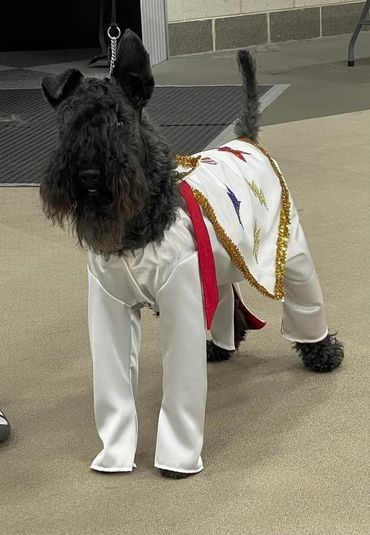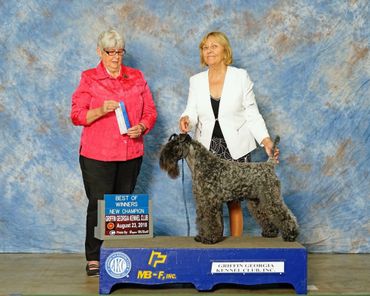Dedicated to a Healthy and Happy Legacy of Kerry Blue Terriers kerry blue t
Lorcan McSassy at Mid Ohio Cluster, Columbus, OH, November, 2025 4x Select B*tch + 3 point major.

Lorcan McSassy at Mid Ohio Cluster, Columbus, OH, November, 2025 4x Select B*tch + 3 point major.


This is my version of a photo of Lorcan McSassy, our 5 yo Kerry female.

CH BELTANE’S AIN‘T MISBEHAVIN’ AT LINDMAR ~ Darcy Dancer (above)
CH BRENRIL COME SAIL AWAY ~ Elvis
CH LINDMAR’S SASSY LASS OF IRISH CLASS ~ Lorcan McSassy (this page)
CH LINDMAR’S FIADH ROISIN ~ Fiadh
LINDMAR’S MAGICAL WREN ~ Wren
Is a Lindmar Kerry Blue Terrier Puppy in your future???
Team Lindmar ~ Lake Lanier Cluster, 4/1/23
Wynter Litter Announcement
Our Kerry Blue Terriers' Health Information
Puppy Litter Announcement ~ Sire and Dam + Impressive Pedigree
Wynter Litter & “L” Litter Photos
Searching for a Breeder and a Puppy
The Kerry Blue Terrier Origin
Characteristics of the Kerry Blue Terrier
💙Elvis, Darcy Dancer, Lorcan McSassy, Fiadh, Wren💙
Our Kerry Kids and their show experience!
Information about the Kerry Blue Terrier breed
AKC Kerry Blue Terrier Breed Standard
Pictures of Our Kerry Kids and some other fun pictures
Contact Information
My Blogs
Lindy & Ted Hickey

With over 10 years of experience in breeding exceptional Kerry Blue Terriers, we strive for the best temperament and best health by picking the best sire and dam allowing us to produce high-quality puppies that will make great show prospects or family pets. We test each of our Kerries to assure their health and wellness. We match individuals and puppies for a perfect pairing and compatibility. We are there for you always. Kerry on 🍀🐾💙
The Kerry Blue Terrier, among the largest of the terrier breeds, is famous for his show-stopping blue coat. The Kerry Blue Terrier originated from Ireland in the mountainous region of County Kerry dating back to the early 1800s. The Kerry Blue Terrier is a rare breed that was originally bred to control "vermin" including rats, rabbits, badgers, foxes, otters and hares. Overtime, the Kerry has became a general working dog used for a variety of jobs including herding cattle and sheep and as a guard dog. The Kerry Blue is also a popular show breed plus being alert, adaptable and animated watchdog. A Kerry Blue Terrier is also a faithful, family companion.

Fiadh, Reign, Wren, Danaher, Maeve
Please take a look at this impressive pedigree of Kerry Blue Terriers who have had success in the conformation show ring. Kerry Blue Terriers excel at Barn Hunt, Agility, Dock Diving, Nose Work, Fast Cat and as Therapy dogs. All of our dogs are healthy. All are tested through Embark. Embark tests for 190+ genetic diseases including MDR1 drug sensitivity, glaucoma, degenerative myelopathy, and dilated cardiomyopathy and some of the most common adult-onset diseases in dogs.

Kerries are so smart!

Fantastic Litter of 5 Kerry Blue Terriers!

Kerries are so sweet!
🍀Lindmar Kerries produces excellent temperaments🍀

































Kerry puppies are born with black coats that must be soft, dense and wavy. The maturing or "clearing" of the coat must be around 18 months of age in order to be shown, but may take longer. The coat color changes as the dog matures to a blue shade of deep slate to a light silver blue-gray. A sporty beard and dark, keen eyes accentuate the nobility of the long terrier head.
The ideal Kerry will be 18.5 inches at the withers for a dog, slightly less for a bitch. Kerry males weigh around 33 to 40 pounds while a female is slightly lighter in weight.
The typical Kerry Blue Terrier should be upstanding well knit and in good balance, showing a well-developed and muscular body with definite terrier style and character throughout. Correct coat and color are important. A low-slung Kerry is not typical. The Kerry has a sporty beard and dark, keen eyes which accentuate the nobility of the long terrier head.
Official Standard of the Kerry Blue Terrier General Appearance: The typical Kerry Blue Terrier should be upstanding well knit and in good balance, showing a well-developed and muscular body with definite terrier style and character throughout. Correct coat and color are important. A low-slung Kerry is not typical. Size, Proportion, Substance: The ideal Kerry should be 18½ inches at the withers for a dog, slightly less for a bitch. In judging Kerries, a height of 18 to 19½ inches for a dog, and 17½ to 19 inches for a bitch, should be given primary preference. Only where the comparative superiority of a specimen outside of the ranges noted clearly justifies it should greater latitude be taken. In no case should it extend to a dog over 20 inches or under 17½ inches, or to a bitch over 19½ inches or under 17 inches. The minimum limits do not apply to puppies. The most desirable weight for a fully developed dog is from 33 to 40 pounds, bitches weighing proportionately less. A well-developed and muscular body. Legs moderately long with plenty of bone and muscle. Head: Long, but not exaggerated, and in good proportion to the rest of the body. Well balanced. Eyes - Dark, small, not prominent, well placed and with a keen terrier expression. Anything approaching a yellow eye is very undesirable. Ears - V-shaped, small but not out of proportion to the size of the dog, of moderate thickness, carried forward close to the cheeks with the top of the folded ear slightly above the level of the skull. A "dead" ear, houndlike in appearance, is very undesirable. Skull - Flat, with very slight stop, of moderate breadth between the ears, and narrowing very slightly to the eyes. Foreface full and well made up, not falling away appreciably below the eyes but moderately chiseled out to relieve the foreface from wedginess. Little apparent difference between the length of the skull and foreface. Jaws deep, strong and muscular. Cheeks-Clean and level, free from bumpiness. Nose - Black, nostrils large and wide. Teeth - Strong, white and either level or with the upper (incisors) teeth slightly overlapping the lower teeth. An undershot mouth should be strictly penalized. Neck, Topline, Body: Neck - Clean and moderately long, gradually widening to the shoulders upon which it should be well set and carried proudly. Back short, strong and straight (i.e., level), with no appearance of slackness. Chest deep and of moderate breadth. Ribs fairly well sprung, deep rather than round. A slight tuck-up. Loin short and powerful. Tail should be set on high, of moderate length and carried gaily erect, the straighter the tail the better. Forequarters: Shoulders fine, long and sloping, well laid back and well knit. The elbows hanging perpendicularly to the body and working clear of the side in movement. The forelegs should be straight from both front and side view. The pasterns short, straight and hardly noticeable. Feet should be strong, compact, fairly round and moderately small, with good depth of pad free from cracks, the toes arched, turned neither in nor out, with black toenails. Hindquarters: Strong and muscular with full freedom of action, free from droop or crouch, the thighs long and powerful, stifles well bent and turned neither in nor out, hocks near the ground and, when viewed from behind, upright and parallel with each other, the dog standing well up on them. Coat: Correct coat is important it is to be soft, dense and wavy. A harsh, wire or bristle coat should be severely penalized. In show trim the body should be well covered but tidy, with the head (except for the whiskers) and the ears and cheeks clear. Color: Color is important. The correct mature color is any shade of blue gray or gray blue from the deep slate to light blue gray, of a fairly uniform color throughout except that distinctly darker to black parts may appear on the muzzle, head, ears, tail and feet. Kerry color, in its process of "clearing," changes from Page 2 of 2 an apparent black at birth to the mature gray blue or blue gray. The color passes through one or more transitions-involving a very dark blue (darker than deep slate), shades or tinges of brown, and mixtures of these, together with a progressive infiltration of the correct mature color. The time needed for this "clearing" process varies with each dog. Small white markings are permissible. Black on the muzzle, head, ears, tail and feet is permissible at any age. A black dog 18 months of age or older is never permissible in the show ring and is to be disqualified. Disqualification - A black dog 18 months of age or older is to be disqualified. (White markings on a black dog 18 months of age or older does not constitute clearing or mature color and the dog is to be disqualified.) Gait: Full freedom of action. The elbows hanging perpendicularly to the body and working clear of the sides in movement; both forelegs and hind legs should move straight forward when traveling, the stifles turning neither in nor out. Disqualifications: A black dog 18 months of age or older is to be disqualified. (White markings on a black dog 18 months of age or older does not constitute clearing or mature color and the dog is to be disqualified.) Approved October 10, 2005, Effective January 1, 2006
Breeders are always up for helping you with grooming.

Kerries love hunting critters and make good barn hunt dogs.

Stacked position is what your Kerry should do in the show ring.
Our babies are adopted quickly, so reach out to reserve your furever friend or to ask any questions. Please contact us so we may send you a Puppy Questionnaire. Our email is LindmarKerries@gmail.com ~ We'd love to hear from you!

We use cookies to analyze website traffic and optimize your website experience. By accepting our use of cookies, your data will be aggregated with all other user data.